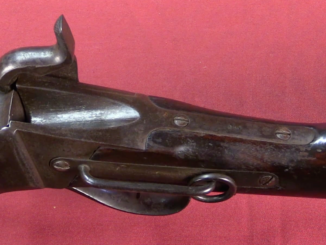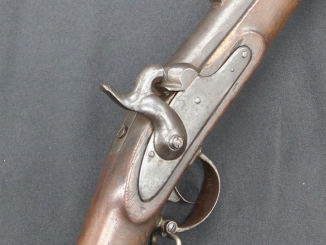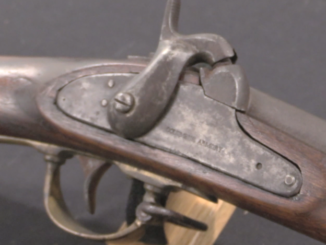Little is known about the Keen-Walker Gun Company, except for a few Confederate arsenal records that have survived. From those we know that the company delivered a total of 282 of these single-shot .54 caliber carbines to the Danville Arsenal in 1862, receiving $50 each for the first 101 and $40 each for the remainder. The company also subcontracted work from the Read & Watson company in Danville, converting Hall rifles.
The carbine made by Keen & Walker bears a substantial resemblance to the Maynard and Perry carbines, although it is not a copy of either one. It is a breechloading design, in which swinging down the trigger guard lever pivots the breechblock upwards for loading with ball and powder or a paper cartridge. A percussion cap is fitted to the nipple on the back of the breechblock for firing. There are no markings on the exterior of the guns save a single-letter proof mark applied when they were accepted by the Confederacy.




This breech construction would speed up operation, for sure. Just one observation – alignment with barrel is less then perfect which may be due to “fatigued” condition of gun. Should this concept become widespread it would have influenced tactics of the time to considerable degree.
Good point Denny. Even modern steel framed revolvers can suffer, eventually, from stretched frames. Bronze would suffer from distortion much sooner.
CG
They look simple and cheap to produce and with a rate of fire higher than the normal muzzleloader it could have been an effective weapon. So, why didn’t they produce more, because the Confederacy was always short on stuff.
The industrial capacity wasn’t there, I’m guessing.
Especially with that blockade.
RE: Tang length
I can think of a few reasons for long tangs, all in agreement with Ian’s observation that they strengthened the stock:
1) While I cannot tell from the video, it is possible that the quality of the wood available (or even type of wood available) may have been second rate for the application, especially considering how short the South was on everything applicable to manufacturing
2) As a cavalry weapon (as practically all breechloading carbines, both North and South, were), it had to be able to withstand possibly being dropped, or thrown, from a horse. Having been thrown from more than one horse in my time, I can assure anyone that breaking things when you hit the ground is absolutely a possibility.
A look at an authentic Hawken rifle will reveal that, as a weapon intended to be carried by a horseman, long upper and lower tangs were the rule (the wood was magnificent, however – weak stocks on a Hawken are practically unknown).
3) As a battle weapon, the possibility of having to use it as a club would certainly exist. Better lengthen those tangs.
CG
That reminds me why many cheap kitchen knives don’t last too long. My mother bought a stainless steel bread knife and tried to use it when cutting her homemade wheat bread. The hollow rubber handle (which had been glued to the blade) slipped off from the stress, revealing that the blade had no tang. Mom was furious that she and Dad had been cheated out of their hard-earned money for a fancy-looking but ultimately useless bread knife.
Exactly. Look at a USMC K-Bar (a notoriously tough knife, designed for combat) – the tang extends completely through the grip, and is solidly peened against the outside of the buttcap.
Best kitchen knife I ever owned, although it required fairly frequent sharpening. But having one come apart is unheard of. Your Mom would have liked it.
CG
Club.
As a history buff, I would like take a moment to thank you for using the correct CSA flag, and not repeating the “stars and bars” fallacy
Are you referring it to the often misused flag? That would be the flag for the confederate army of Virginia, which should never be considered a symbol of white supremacy. Robert E Lee would be ashamed of the racist thugs running around today with his flag… I probably messed up somewhere.
Symbol connotations are effects of actions of its users rather than symbol itself (given abstract enough symbol)
Hakenkreuz is most obvious example – in fact in early 20th century it was considered positive or neutral – just nice symbol for architecture decorating or as trademark (cf. Swastika Laundry active in Dublin and Allmänna Svenska Elektriska Aktiebolaget).
There is a lot of evidence that the link between the loading lever and the breech suffered bending stress that gradually prevented the breech from completely closing and pressing against the barrel. This copy clearly shows that. Also the bent and broken loading levers on some of the survivors indicates jamming was a problem after several shots. There is an internal drawing of the Keen and Walker carbine in Chapter XII of Murphy’s Confederate Carbines and Musketoons. I forgot where I found a PDF copy on the net. A clever idea for a simple breechloader. Several design improvements could have made it a better firearm but like so many civil war ideas it was discarded when integrated metal cartridges took off.